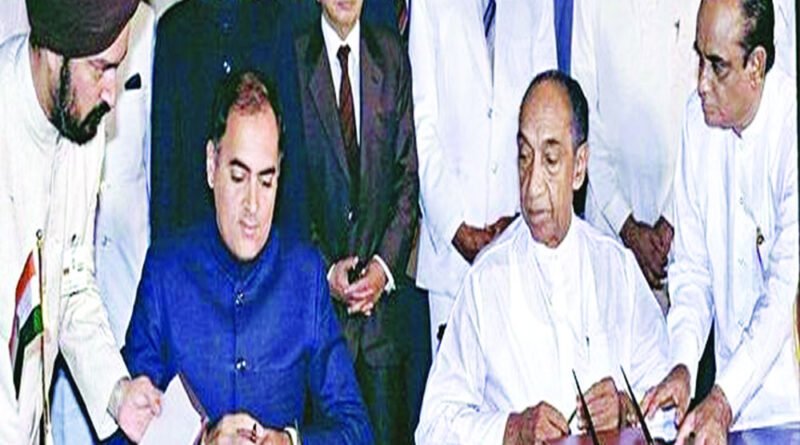Of Sri Lanka and the Andamans
The issues between Sri Lankan Tamils and the Sinhalas may be resolved if India concurs to transfer the former to the Andamans
Two communities not being able to coexist is a perennial problem in the Indian subcontinent. An old saying goes, “Ek myaan mein do talwarein nahi reh sakti”, meaning two swords cannot fit into one scabbard. The problem began by being underscored in our own India, which was divided into Pakistan for Muslims and Hindustan for the rest. MA Jinnah argued that Hindus and Muslims were two separate nations and could not coexist. The first leader to push this two-nation thesis was Sir Syed Ahmad Khan of Aligarh fame.
Some UP Muslims believed their new country, Pakistan, was a new Medina. Muslims in the western wing despised easterner Bengalis as inferior, short and dark. Their economy was exploited from day one. Jinnah visited Dacca early in 1948 and peremptorily told university students that Urdu alone would be Pakistan’s national language. Bengali, which they are proud of, was not in the reckoning. The two wings were daggers drawn from 1948; the clash came in 1971, in less than 24 years of the new Medina’s birth. In December that year, they separated; Bangladesh was born.
Thus, India was divided into three. Now we hear that the people of Sindh wish to separate. This separatist movement is called “Jio Sindh”. They are unable to exist under the yoke of the dominant Punjabis. Baluchistan is another unhappy province which was partly British India and partly the princely State of Kalat. It had an Embassy in Karachi until 1948 when Pakistan forcibly took it over. The Pathans of the North-West Frontier Province (NWFP) with their main city, Peshawar, have always wished to unite with all Pathans in Afghanistan, though this demand is dormant now.
With Sri Lanka, it is an old problem. I visited my in-laws-to-be in Colombo in 1964 as they wanted to introduce me to their society in the city where they had lived and worked for 32 years. In the course of my four-day stay, there arose the question of who would be the next managing director of the British Ceylon Corporation, a British firm similar to the one we had in Kanpur, the British India Corporation, until the early 1960s. My father-in-law said that one Ramaswamy, a local Tamil, was the ablest choice but was unlikely to get the promotion. The prize was likely to go to DM Pereira as he was a Sinhala. The existing Board of directors was largely British, headed by a distinguished gentleman called Singleton-Salmon. There was no partiality in the company but the emerging milieu in Colombo was such. Ramaswamy was likely to emigrate to Australia.
My father-in-law explained that the Sinhalas were an overwhelming majority, an easy-going, fun-loving Buddhist people. They were jealous of the Tamils who were serious at work, and more efficient. There had developed a wedge between the two groups as far back as then. Their differences were bound to explode sooner or later. The fact that the people of Tamil Nadu have a soft corner in their hearts for their Sri Lankan brethren is natural but that makes the Sinhalas suspect Indian intentions from time to time. When Rajiv Gandhi was India’s Prime Minister and President JR Jayewardene headed Sri Lanka, we sent the IPKF military to help the Tamils. Instead of helping them, we only killed them and left the Sinhalas alone. This indicates that our Governments have mostly not understood Sri Lankan affairs.
Colombo’s rulers smile at New Delhi and pretend to be friendly although they feel that the faraway yellow giant is less dangerous than the Indian giant, only 40 km to the north. They did appreciate the IPKF’s help for some time; thereafter it became a distant memory. Lanka appears to have erred in owing China all the money for upgrading the Hambantota port as well as a highway from Colombo to Galle and further south. If Sri Lanka cannot repay the loan in time, these may be taken over as Chinese property. Yet Colombo would rather deal with Beijing than New Delhi. This mentality is likely to continue indefinitely until India takes a drastic stop to relieve the Sinhalas of their Tamil suspicions. From the Indian point of view, there is the fear, however remote, that one day the Chinese may convert Sri Lanka into a yellow colony.
What should New Delhi do? Consider whether we can offer a transfer of willing Sri Lankan Tamils to the Andaman Islands. They are a community of four million people, mainly in the Jaffna area in the northeast of Sri Lanka and some scattered across the east of the island. The Andamans occupy about 9,000 sq km with only about four lakh people. Not all Sri Lankan Tamils are likely to accept the transfer. For those willing, Sri Lanka should pay a total Rs 2 lakh per head towards resettlement, convenience costs and compensation. This means several billion rupees for Sri Lanka to borrow or somehow fork out, but a small cost for solving their greatest problem. India’s advantage would be populating the Andaman Islands, which makes Tamils’ survival safer, Tamil Nadu happier and the Indo-Sri Lankan relations permanently suspicion-free.
(The writer is a well-known columnist and an author. The views expressed are personal.)
Source: The Pioneer




